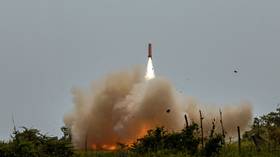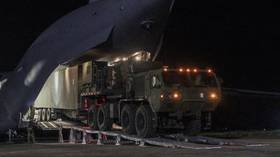Beijing declares that Washington's decision to install medium-range ballistic missiles poses a serious danger to the stability and peace in the region.
China warns of US plans to deploy ballistic missiles in Asia-Pacific
Chinese Defense Ministry spokesperson Wu Qian told reporters that his country "strongly opposes the deployment of US intermediate-range missiles in the Asia-Pacific region, this position is clear and consistent."
He also warned that Washington's move poses a serious threat to the stability and peace in the region.
Read more: China opposes US including Taiwan in aid bill passed by Congress
China's US embassy said in early April that the US must refrain from introducing bloc confrontation, conflict, and turmoil to the Asia-Pacific, confirming that "China is firmly opposed to it."
Russia also expressed deep concern regarding the United States' move.
'Russia must respond."
Read more: Kiev already used long-range ATACMs US secretly sent to Ukraine
Deputy Foreign Minister Sergey Ryabkov expressed concerns on Thursday, saying that the "US’ determination to acquire such potential and use it within the framework of the concept of dual deterrence is irreversible."
"As it was recently discussed during the visit of Russian Foreign Minister [Sergey Lavrov] to Beijing, we must respond to double containment with double counteraction. One of the points of such counteraction will undoubtedly be a revision of our approach to the unilateral moratorium on the deployment of such systems announced in 2018 by our president [Vladimir Putin]," he told reporters on April 11.
US missile launcher deployed to Philippines ‘defensive in nature’
2024.04.25
Manila
 U.S. and Philippine soldiers fire Javelin shoulder-launched anti-tank missiles during exercises at Fort Magsaysay, Nueva Ecija province, northern Philippines, April 13, 2023.
U.S. and Philippine soldiers fire Javelin shoulder-launched anti-tank missiles during exercises at Fort Magsaysay, Nueva Ecija province, northern Philippines, April 13, 2023.The U.S. Army’s deployment of a mid-range missile launcher in the Philippines this month is defensive in nature and temporary, according to an American general in the Southeast Asian nation for joint military exercises.
The Mid-Range Capability (MRC) missile system – also known as the Typhon System – has been positioned on the northern island of Luzon for this year’s “Balikatan” exercise that involves more than 16,000 troops and an array of major military hardware.
China has protested the deployment of the missile launcher, accusing Manila and Washington of aggravating tensions that have flared recently over territorial claims in the South China Sea.
“We are not looking for a fight. Everything we do is defensive in nature,” Lt. Gen. Michael Cederholm, commander of the U.S. 1st Marine Expeditionary Force, told reporters Wednesday when asked about the Chinese remarks.
Cederholm would not say how long the MRC system would stay in the country, but he assured the public its deployment was only for America’s Filipino allies to learn how to use it.
“I think it's pretty straight forward that we are bringing a defensive capability that is fairly new and we are figuring out how to interoperate [while] moving around in various spots that we are going to deploy it,” he said.
“It’s a defensive posture. When we are done training with it, we will bring it back home and continue to develop our tactics, techniques, procedures,” he said.
The Typhon System can fire the Standard Missile 6 (SM-6) and Tomahawk missiles and support strike capabilities from land, sea and air.
It was designed for extended-range anti-air warfare against ballistic missiles, with an operational range of more than 240 km (150 miles) and an active radar homing guidance system that allows the projectile to find and track its target autonomously.

The Balikatan (shoulder-to-shoulder) drills started Monday and involve 11,000 troops from the U.S. and 5,000 from the Philippine side, along with hundreds from Australia and France.
This year, the Americans have dedicated ships, aircraft including their F-22 Raptor fighter jets, and medium-range capability weapons system, among others, for the exercise.
The Philippine military will be showcasing some of the military hardware it acquired for its modernization program, including a frigate, FA-50 fighter jets, and Super Tucano light attack aircraft.
As part of the exercise, maritime drills between France, the U.S. and the Philippines are scheduled from April 25 until May 4. For the first time, a joint sail will take place outside the Philippines’ territorial waters – beyond the 12 nautical-mile mark, but within the exclusive economic zone.
The main event will be a ship sinking exercise in which participants will have to test the interoperability of their weapons systems to strike a mock enemy ship, the Chinese-made BRP Lake Caliraya (AF-81), off the coast of Laoag in Ilocos Norte on May 8.
Col. Michael Logico, the Philippine Balikatan spokesman, said the vessel was chosen because it was the right size for the exercise and the military did not know it was made in China.
Beijing has criticized the annual drills, saying they are provocative and that its position on the South China Sea remained clear.
Beijing claims nearly all of the disputed waterway and dismisses overlapping claims from the Philippines, Malaysia, Brunei, Vietnam and Taiwan.
Earlier this week, the Philippine Navy reported an increase in the number of Chinese maritime militia vessels in the South China Sea, coinciding with the start of the joint military exercises.
Don McLain Gill, a geopolitical analyst at De La Salle University’s international studies department in Manila, said the message behind the drills was “very clear.”
“Given what is happening today in the West Philippine Sea where China is pursuing the expansion of its forces, this actually adds more significance to the Balikatan,” he said.
“The Marcos administration cites what is taking place in the West Philippine Sea should be in the interest of the Filipino people and Philippine national interest,” he said.
The 39th edition of the annual exercise is being carried out under the two countries’ 1951 Mutual Defense Treaty that calls on both countries to aid each other in times of aggression by an external power.
Jason Gutierrez, Jeoffrey Maitem and Mark Navales reported from Manila
25 Apr, 2024 15:45
China threatens US with response to missile deployment

Beijing has condemned Washington’s deployment of intermediate-range missiles in the Asia-Pacific region and will take all effective measures to prevent the US from “messing up” the South China Sea, Chinese Defense Ministry spokesman Wu Qian said on Thursday.
His comments come after the US kicked off its largest joint exercise with the Philippines since the Cold War in the South China Sea earlier this week. The exercise, dubbed Balikatan, is set to run through May 10 and is said to involve over 11,000 US soldiers and 5,000 Philippine servicemen. A French frigate as well as troops from France and Australia are also participating in the event.
- The weapon has a maximum range of more than 400km while a new medium-range MRC Typhon land missile system is capable of launching from the Philippines island of Luzon.
- “We hope the relevant country could refrain from opening the door to the devil, which will only end up hurting everyone, including itself,” the spokesman said.
- However, he stressed that such relations must not harm China’s, or any other country’s interests, and must not undermine peace and stability in the region.
China's military will continue to pay close attention to the situation in the region and will take “all effective measures to respond effectively and will never allow relevant parties to mess up the South China Sea,” Wu added. Russia’s ambassador to the US Anatoly Antonov said earlier that the Pentagon’s deployment of medium-range missiles in the Philippines would constitute a “dark day” for international security and accused Washington of deliberately escalating military confrontation, fueling hotbeds of tension and creating closed groups and military-political alliances in the region.
“[The US] is trying to return the world to the worst times of the Cold War and teetering on the edge of a nuclear conflict,” Antonov said earlier this month, urging Washington not to open this “Pandora’s box.”





No comments:
Post a Comment